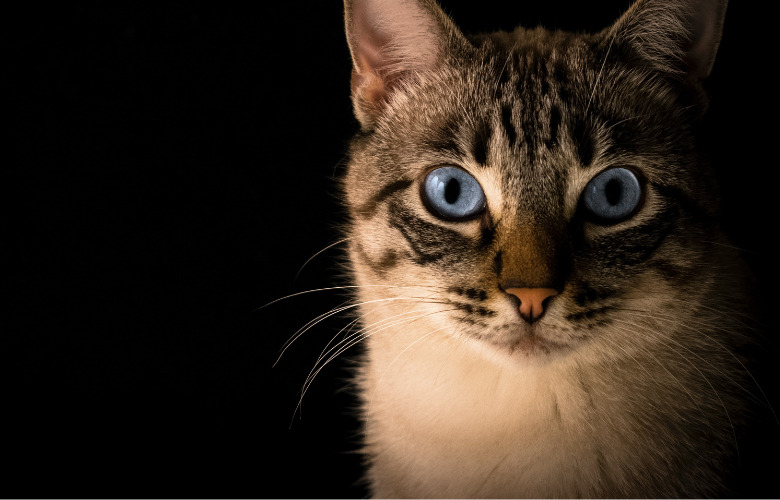
The Moscow Cat Theatre is the only place in the world that engages street cats as actors in professional stage performances. In an interview with the Anadolu Agency in 2019, the renowned Russian artist Dmitry Kuklachev explained how street cats can become famous actors.
The Moscow Cat Theatre was created approximately 30 years ago. It is one of the off-the-beaten-path tips for any cat and theatre aficionados passing through the large Russian metropolis.
In the Cat Theatre, the street cats are the stars of the show. Everyone knows how hard or rather impossible it is to train a cat. Even more so a street cat. Yet, in the show, cats ride on bikes, walk on a wire, perform acrobatics, and even aerial acts.
The theatre’s artistic director Dmitry Kuklachev says, “A cat will never do anything under constraint, but it is possible to come to a mutual agreement with cats, by using their natural abilities and needs.”
Additionally, if there is love and mutual understanding more is possible than you’d ever imagine. In general, love and respect give more than forceful training.”
“It is impossible to punish a cat backstage and then make her perform tricks onstage. It doesn’t work. Only patience and understanding does.”
As every performer does, Kuklachev searched for his very own signature move. For something to set him apart from other artists and clowns. Something to make his own. And something to be remembered for.
Kuklachev says, “One day I found a kitten. It was very communicative and friendly. And, during a curtain call, it so happened that I decided to come out with the kitten on my shoulder.”
“I saw how warmly the spectators reacted to this. So, I began developing some of my tricks with cats. Then, after twenty years in the circus, I established my own theatre.”
About two hundred feline performers live in the theatre. The theatre offers twelve different performances for its audiences. The cats and their acts are distributed throughout.
Kuklachev is enthusiastic, “We have twelve different performances in our theatre. I’m saying it proudly, because in contrast to dramatic theatres, we need four to five years to be able to present a new show. Creation with cats can only be done in accordance with the natural pace of each individual cat.”
It takes about a year to prepare a new performer. From its first appearance in the theatre to the entrance upon the stage.
The cats must go through two tests to be cast for the shows. First, a casting based on talent. Then, tests to confirm their good health. Since they will live in the feline theatre commune, this is best for the overall longevity and safety backstage.
“A cat must possess different talents. It must be playful, curious, and loose. How do we know it fulfils those requirements? In a new place, each respective cat should feel like a master.”
“For example, brought here, it should explore everything, sniff around immediately. This is the sign of a future artist.”
“Not all animals have these traits. After passing the casting, the cats undergo a physical examination. They undergo blood tests for eight different diseases.”
For about a month, the cat lives in quarantine, separate from other cats. If all tests come back clean, then, after another two to three weeks, we begin to adapt the cat to the rest of the company.”
“If somehow the cat can’t be integrated into the existing company, we make sure we find them a good forever home,” says Dmitry Kuklachev.
In the beginning, the theatre found new artists everywhere on the streets and in animal shelters. After all these years since its opening, the theatre’s family has grown massively. So, now most of the actors are offspring from within the theatre company.
“About four months ago we had seventeen kittens. Eight of them remained in the theatre.”
“Each of our cats performs its own trick. They have their own acts. My task is to notice the skills, and to develop them. So that the cat will love to perform the same trick for a long time.” Kuklachev explains.
The theatre has its leading performers and stars. One of them is a tomcat called Boris. He is now also famous in Russia for advertising cat food.
When the cats grow old, they remain in the theatre, taking advantage of good care and being spoiled during their retirement.
Kuklachev smiles, “The compensation of our cat performers is their good mood, delicious food, a great backstage community, and a comfortable old age.”
Over the years, the Moscow Cat Theatre has been involved in several controversies since many animal rights groups insist that Kuklachev’s claims are not correct.
They say that the animals are, in fact, abused.
However, Kuklachev has won several lawsuits that were brought against him. To this day, even after several investigations, no animal abuse has ever been proven.
Moscow’s Cat Theatre on ‘Opera and Ballet.com’
Moscow’s Cat Theatre on Atlas Obscura
Le Temple du Present – Solo for an Octopus
Bewegtes Land, an Art Project For Train Passengers


Liam Klenk was born in Central Europe and has since lived on four continents. Liam has always been engaged in creative pursuits, ranging from photography and graphic design, to writing short stories and poetry, to working in theatre and shows. In 2016, Liam published his first book and memoir, 'Paralian'.
Read Full Profile© 2021 TheatreArtLife. All rights reserved.

Thank you so much for reading, but you have now reached your free article limit for this month.
Our contributors are currently writing more articles for you to enjoy.
To keep reading, all you have to do is become a subscriber and then you can read unlimited articles anytime.
Your investment will help us continue to ignite connections across the globe in live entertainment and build this community for industry professionals.